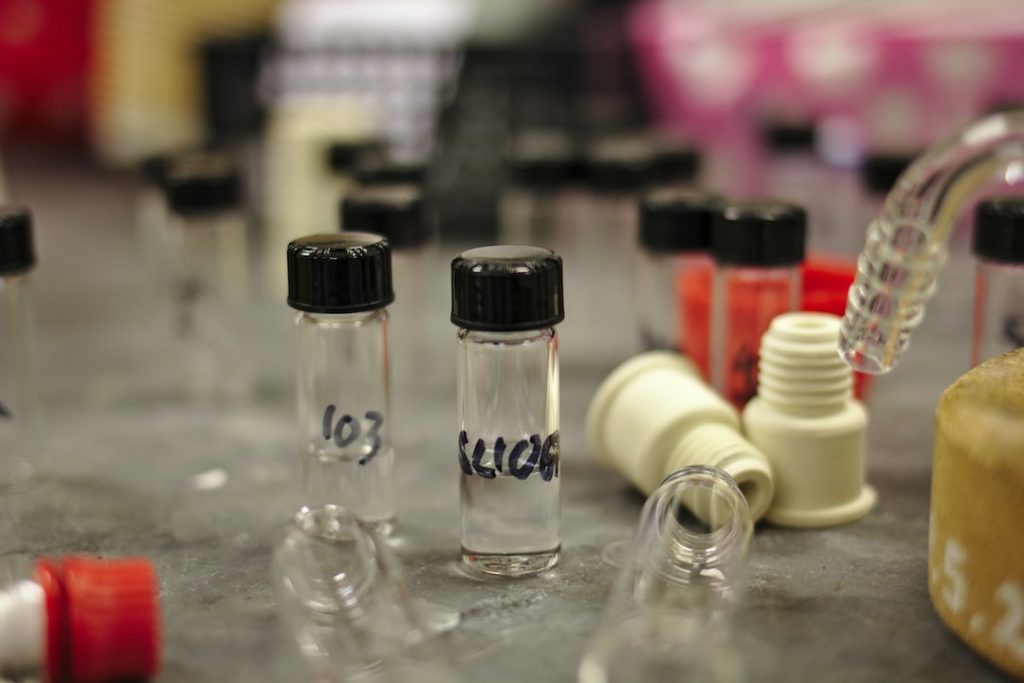Transition metals are a group of elements that are found in the middle of the periodic table, between the main group elements and the inner transition metals. They are characterized by their unique properties, which set them apart from other elements. Transition metals have partially filled d orbitals, which allows them to exhibit a wide range of oxidation states and form complex compounds. They also have high melting and boiling points, good electrical conductivity, and are often highly resistant to corrosion.
One of the key properties of transition metals is their ability to form stable coordination complexes with ligands. This property is due to the presence of empty d orbitals, which can accept electron pairs from ligands. These coordination complexes have a wide range of applications in various fields, including electronics, telecommunications, automotive industry, sustainable energy technologies, medicine, agriculture, environmental science, and materials science.
Key Takeaways
- Transition metals have unique properties such as high melting and boiling points, variable oxidation states, and magnetic properties.
- Transition metals are used in electronics and telecommunications for their conductivity and magnetic properties.
- Transition metals are used in the automotive industry as catalysts for emissions control and as materials for lightweight construction.
- Transition metals play a crucial role in sustainable energy technologies such as solar cells and fuel cells.
- Transition metals have diagnostic and therapeutic applications in medicine, and are used in agriculture as fertilizers and pesticides.
Applications of Transition Metals in Electronics and Telecommunications
Transition metals play a crucial role in the field of electronics and telecommunications. They are used in the production of electronic devices such as transistors, integrated circuits, and memory chips. Transition metals such as copper, silver, and gold are excellent conductors of electricity and are commonly used as interconnects in electronic circuits. They have low resistivity and high thermal conductivity, making them ideal for carrying electrical signals.
In telecommunications, transition metals are used in the production of optical fibers. These fibers are made from silica glass doped with transition metal ions such as erbium or neodymium. When these ions are excited by a laser beam, they emit light at specific wavelengths, which can be used to transmit information over long distances. Transition metals also play a role in the development of magnetic storage devices such as hard drives. They are used as magnetic materials in the production of read/write heads and storage media.
Transition Metals in the Automotive Industry: Catalysts and Materials
Transition metals are widely used as catalysts in the automotive industry, particularly in the exhaust systems of vehicles. Catalytic converters, which are installed in the exhaust systems of cars, contain transition metal catalysts such as platinum, palladium, and rhodium. These catalysts help to convert harmful pollutants such as carbon monoxide, nitrogen oxides, and unburned hydrocarbons into less harmful substances such as carbon dioxide, nitrogen, and water vapor.
In addition to their use as catalysts, transition metals are also used in the production of lightweight materials for vehicles. For example, magnesium alloys containing transition metals such as aluminum and zinc are used to make lightweight components such as engine blocks and body panels. These alloys have high strength-to-weight ratios and excellent corrosion resistance, making them ideal for use in the automotive industry.
The Role of Transition Metals in Sustainable Energy Technologies
| Transition Metal | Sustainable Energy Technology | Metric |
|---|---|---|
| Cobalt | Lithium-ion batteries | High energy density |
| Nickel | Fuel cells | Efficient conversion of hydrogen to electricity |
| Iron | Solar cells | Efficient electron transfer |
| Manganese | Wind turbines | High strength and durability |
Transition metals play a crucial role in the development of sustainable energy technologies. They are used in various renewable energy technologies such as solar cells, fuel cells, and wind turbines. For example, transition metal compounds such as titanium dioxide and ruthenium complexes are used as photoactive materials in dye-sensitized solar cells. These materials absorb sunlight and convert it into electrical energy.
Transition metals also play a role in energy storage systems such as batteries and supercapacitors. Lithium-ion batteries, which are commonly used in portable electronic devices and electric vehicles, contain transition metal compounds such as cobalt oxide and nickel manganese cobalt oxide. These compounds help to store and release electrical energy efficiently.
Transition Metals in Medicine: Diagnostic and Therapeutic Applications
Transition metals have important applications in the field of medicine. They are used in medical imaging techniques such as magnetic resonance imaging (MRI) and positron emission tomography (PET). MRI uses transition metal ions such as gadolinium to enhance the contrast between different tissues in the body, allowing for the detection of abnormalities. PET uses radioactive transition metal isotopes such as copper-64 and gallium-68 to label molecules that can target specific tissues or diseases.
Transition metals also play a role in cancer treatment. Certain transition metal compounds, such as platinum-based drugs like cisplatin and carboplatin, are used as chemotherapy agents. These drugs work by binding to DNA and interfering with its replication, thereby inhibiting the growth of cancer cells. Other transition metal compounds, such as iron complexes, are being investigated for their potential use in targeted cancer therapies.
Transition Metals in Agriculture: Fertilizers and Pesticides

Transition metals are used in the field of agriculture for the production of fertilizers and pesticides. They are essential micronutrients for plant growth and development. Transition metal ions such as iron, manganese, copper, and zinc are required in small amounts by plants for various physiological processes. For example, iron is necessary for chlorophyll synthesis, while copper is involved in enzyme activation.
Transition metals also play a role in pesticide development. Certain transition metal compounds, such as copper-based fungicides and insecticides, are used to control plant diseases and pests. These compounds work by disrupting the metabolic processes of pathogens or pests, leading to their death or inhibition of their growth.
Transition Metals in Environmental Science: Remediation and Pollution Control
Transition metals have important applications in environmental science, particularly in the areas of remediation and pollution control. They are used in the remediation of contaminated soils and waters. Transition metal ions such as iron and manganese can be used to remove pollutants such as heavy metals and organic contaminants from contaminated sites. These ions can react with pollutants to form insoluble precipitates or can catalyze the degradation of contaminants.
Transition metals also play a role in pollution control. For example, catalytic converters in vehicles contain transition metal catalysts that help to reduce harmful emissions. Transition metal compounds such as titanium dioxide are used as photocatalysts in air purification systems. These compounds can break down pollutants such as volatile organic compounds and nitrogen oxides under the influence of light.
Transition Metals in Materials Science: Alloys, Nanomaterials and Composites
Transition metals have important applications in materials science. They are used in the development of alloys, which are mixtures of two or more elements, including transition metals. Alloys containing transition metals such as iron, nickel, and chromium are used in the production of stainless steel, which has high strength, corrosion resistance, and heat resistance. Other transition metal alloys, such as titanium alloys and aluminum alloys, are used in aerospace and automotive applications due to their high strength-to-weight ratios.
Transition metals also play a role in the production of nanomaterials and composites. Nanomaterials are materials with dimensions on the nanometer scale, typically less than 100 nanometers. Transition metal nanoparticles, such as gold nanoparticles and silver nanoparticles, have unique optical, electrical, and catalytic properties that make them useful in various applications. Transition metal composites, which consist of a transition metal matrix reinforced with another material such as carbon fibers or ceramic particles, have high strength and stiffness.
Future Prospects and Challenges in Transition Metal Research
The field of transition metal research holds great promise for future applications. There is ongoing research into the development of new transition metal catalysts for various chemical reactions, including those involved in renewable energy production and carbon dioxide capture. There is also interest in exploring the potential use of transition metals in emerging technologies such as quantum computing and nanoelectronics.
However, there are also challenges that need to be addressed in the development and use of transition metals. One challenge is the limited availability of certain transition metals, particularly those that are rare or have limited reserves. This can lead to supply chain issues and increased costs. Another challenge is the potential environmental impact of transition metal mining and processing. The extraction and processing of transition metals can result in the release of pollutants and the generation of waste.
The Importance of Transition Metals in Modern Science and Technology
In conclusion, transition metals play a crucial role in modern science and technology. They have unique properties that make them useful in a wide range of applications, including electronics, telecommunications, automotive industry, sustainable energy technologies, medicine, agriculture, environmental science, and materials science. Transition metals are used as catalysts, materials, and components in various devices and systems. Continued research and development in the field of transition metal research is important for the advancement of these technologies and the development of new applications.
FAQs
What are transition metals?
Transition metals are a group of elements in the periodic table that have partially filled d orbitals in their atomic structure. They are located in the middle of the periodic table and include elements such as iron, copper, nickel, and gold.
What are some properties of transition metals?
Transition metals have high melting and boiling points, are good conductors of heat and electricity, and are often malleable and ductile. They also have a wide range of oxidation states and can form complex ions and compounds.
What are some common uses of transition metals?
Transition metals have a wide range of uses, including in construction, electronics, transportation, and medicine. For example, iron is used in the production of steel, copper is used in electrical wiring, and platinum is used in catalytic converters in cars.
What is the importance of transition metals in biological systems?
Transition metals play important roles in biological systems, such as in enzymes that catalyze chemical reactions in the body. For example, iron is a component of hemoglobin, which is responsible for transporting oxygen in the blood.
What are some environmental concerns related to transition metals?
Some transition metals, such as mercury and lead, can be toxic to humans and the environment. They can accumulate in the food chain and cause health problems. Proper disposal and management of these metals is important to prevent environmental contamination.


